 |
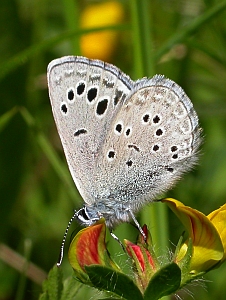 Black-eyed Blue
Black-eyed Blue
Glaucopsyche melanops
© Teresa Farino
Spring Butterflies & Moths
The perfect season for an outstanding assemblage of Lepidoptera in the Picos de Europa
Early June brings out a wealth of spring butterflies in the valleys and middle altitudes of the Picos de Europa. Given warm sunny weather we can expect to see around 60 species, including both Swallowtails, Chequered, Dingy, Lulworth, Southern Grizzled and Red-underwing Skippers, Provence Orange Tip 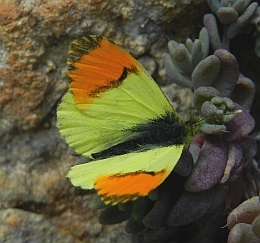 Provence Orange Tip Provence Orange Tip
Anthocharis eupehnoides© Teresa Farino, Black-veined, Bath and Wood Whites, Duke of Burgundy Fritillary, Sooty Copper, Spanish Purple hairstreak, Turquoise, Adonis, Black-eyed and Green-underside Blues and emblematic fritillaries such as Marsh, Meadow, Glanville, Knapweed, Spotted, Pearl-bordered and Queen of Spain.
As this tour is timed to coincide with the dark of the moon, we can expect some impressive moth catches, weather permitting. Since Teresa launched the Picos de Europa Lepidoptera Study in 1989, she and her team of recorders have cited more than 820 species of macromoths in the region, with new ones coming to light every year. Since we started participating in European Moth Nights in 2006, Teresa's terrace in Pesaguero has consistently been among the top localities right across Europe in terms of the diversity of macromoths recorded, most recently being placed second in 2010, fourth in 2011 and (provisionally) first in June 2012, with an incredible 182 species of macromoth over the five nights.
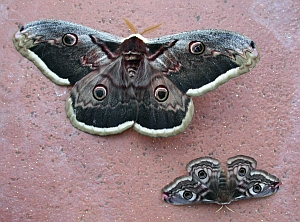 Giant Peacock Moth + Emperor Moth Giant Peacock Moth + Emperor Moth
Saturnia pyri + S. pavonia© Teresa Farino
Probably the most magnificent moth on the wing at this time of year is the Giant (or Great) Peacock Moth; Europe's largest, with a wingspan of around 15cm. On occasions in the past we've had up to seven of these beauties in my terrace trap in a single night! To give you an idea of how big it is, check out the photo of this individual next to an Emperor Moth, the latter also an occasional visitor to my trap in spring. We should also keep an eye out for a third member of the Saturniidae on our daily forays – the Tau Emperor – the males of which fly during the day in montane beechwoods.
Many members of the Notodontidae also come to light in May, including such British rarities as Tawny and Three-humped Prominents and Dusky Marbled Brown, together with Great, Pale, Pebble, Swallow, Coxcomb and Iron Prominents, and Lobster Moth, Buff-tip and Poplar Kitten. Non-UK species of interest in this family regularly seen in the Picos include the Iberian endemic Spanish Puss Moth, Oak and Indistinct Marbled Browns and The Javelin. May is also one of the peak periods for hawkmoths, with Elephant, Small Elephant, Lime, Striped, Poplar, Privet and Southern Pine all regular visitors to the Pesaguero trap at this time of year. During the day we'll certainly come across plenty of Hummingbird Hawkmoths, and might be lucky enough to add Narrow-bordered Bee Hawkmoth to our list too.
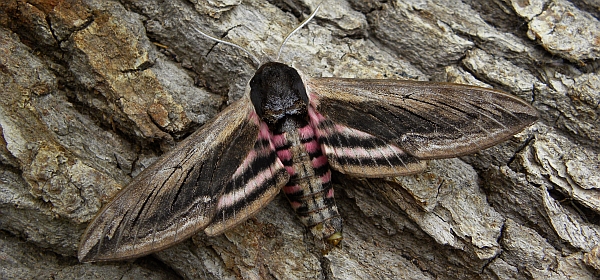 Privet Hawkmoth Sphinx ligustri© Teresa Farino Privet Hawkmoth Sphinx ligustri© Teresa Farino
We should also encounter some of the more emblematic tiger moths of the Picos de Europa, with the highlight undoubtedly being the Iberian endemic Spanish Tiger. Other attractive nocturnal arctiids on the wing at this time of year include Cream-spot Tiger and non-British gems such as The Tiger and Chaste Pellicle, with our day trips providing us with the opportunity to track down Wood Tiger and Feathered Footman.
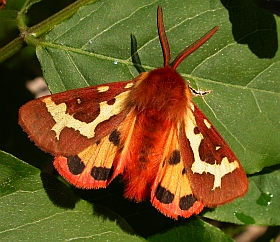 Spanish Tiger Hyphoraia dejeani© Teresa Farino Spanish Tiger Hyphoraia dejeani© Teresa Farino
A huge list of geometrids is also on offer at this time of year, with some of the light-attracted species of interest to UK 'mothers' being British rarities such as Horse Chestnut, Great Oak Beauty, Sloe and Ruddy Carpets and The Mocha, with day-flying highlights including Frosted Broom, Black-veined Moth, Narrow Rose-banded Wave and Drab Looper. At altitude we can also expect to encounter good numbers of the splendid Crowned Moth.
A similar impressive diversity can be seen among the Erebidae, with the trio of The Passenger, The Alchymist and Lunar Double-stripe of particular note, plus Purple Marbled as an aside. Noctuids of interest on offer in early June include Dewick's Plusia, Lorimer's Rustic, Orache Moth, Pale-shouldered Cloud, White Spot, L-album Wainscot and Silver Clouds galore. Other sundry mid-May macromoths that might raise an eyebrow or two are Goat Moth and Garlic Mottled (Cossidae) and Black V Moth (Lymantriinae), with Slender Scotch Burnet on offer during the day.
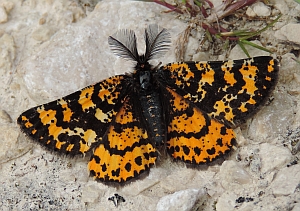 Male Crowned Moth Eurranthis plummistaria© Teresa Farino Male Crowned Moth Eurranthis plummistaria© Teresa FarinoIf the weather is poor in the Picos, we'll take the opportunity to head south for a day into the limestone plateaux of Palencia, where we should be able to add species like Spanish Festoon, Safflower Skipper and Osiris, Panoptes and Chequered Blues to our butterfly list, and where there is also a chance that we might encounter the fabulous Banded Tiger (Eucharia festiva). If we venture in a more westerly direction, however, we could visit a known locality for Geranium Argus.
Although we will be focussing primarily on the butterflies and moths, we will be hard put to ignore the other super-abundant wildlife of these mountains, including a wealth of birds and spring flowers, many amphibians and reptiles, and the odd mammal. And all this against a superb backdrop of jagged peaks towering over green valleys dotted with small, red-roofed villages, where livestock farming in harmony with the environment is still the order of the day.
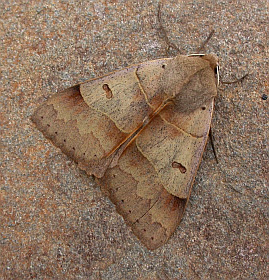 Lunar Double-stripe Minucia lunaris© Teresa Farino Lunar Double-stripe Minucia lunaris© Teresa Farino
NB For the duration of the tour, you will be covered by Teresa's permits both to catch butterflies and trap moths (a legal requirement for Spain).
All the lepidoptera records we collect will be submitted to the Cantabrian and Castilla y León regional governments, as well as to the Picos de Europa national park authorities, as part of the Picos de Europa Lepidoptera Study, initiated by Teresa in 1989.
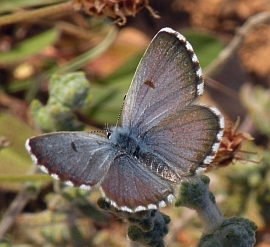 Male Panoptes Blue Pseudophilotes panoptes© Teresa Farino Male Panoptes Blue Pseudophilotes panoptes© Teresa Farino
Spring Butterflies & Moths
Leader: Teresa Farino
2017 Dates: Thursday 11 May – Tuesday 16 May
(6 days / 5 nights)
Price: 970€, including half-board, en suite accommodation at Posada El Hoyal, picnic lunches, minibus/4WD transport throughout, all entry fees and the services of Teresa Farino as leader. A single-room supplement of 110€ is applicable.
Although the cost of the tour is given in euros, clients may pay in sterling, the exchange rate to be calculated at the time of payment using www.oanda.com
This is a land-based tour. Flights and travel insurance (obligatory) are the responsibility of the client.
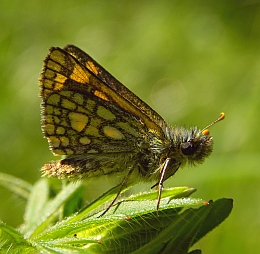 Chequered Skipper Chequered Skipper
Carterocephalus palaemon© Teresa Farino
Pick-up details: For this tour, clients will be booking their flights independently. Teresa will be meeting the British Airways flight from London Heathrow to Bilbao, which gives us by far the most convenient flight times for these dates as well as almost six full days in the field. Details are as follows:
11 May BA0466
Departs London Heathrow at 08.25
Arrives Bilbao at 11.25
16 May BA0469
Departs Bilbao at 19.40
Arrives London Heathrow at 20.30
Alternatively, those travelling to the Picos independently can arrange to meet the group at Posada El Hoyal on the first evening.
Group size: maximum 8 clients.
Booking information: please contact Teresa Farino for further details and a booking form, or if you have any queries about these tours.
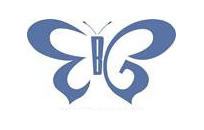
| E-mail: |
|
|
| Office phone: | (+34) 942 735154 |
| Mobile phone: | (+34) 656 337129 |
|
| Address: |
Apartado de Correos 59
39570 Potes
Cantabria
Spain
|
|